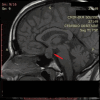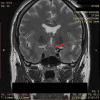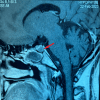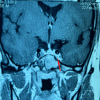Medical and Surgical Approaches for a Non-functioning Pituitary Adenoma During Pregnancy
- PMID: 38571819
- PMCID: PMC10990650
- DOI: 10.7759/cureus.55512
Medical and Surgical Approaches for a Non-functioning Pituitary Adenoma During Pregnancy
Abstract
Non-functioning pituitary adenomas (NFPA) are most commonly found in post-menopausal women and men above the age of 50. They are mainly revealed by a tumor syndrome. The incidence of symptomatic NFPA during pregnancy is rare, with only nine documented cases in the literature. The patient was 39 years old with no previous medical or surgical history and was 17 weeks pregnant. A large pituitary macroadenoma measuring 17 x 18 x 19 mm was discovered radiologically in the presence of a pituitary tumor syndrome. Clinical examination revealed no signs of hormone deficiency or hypersecretion. A corticotropic and thyrotropic deficit was ruled out following a hormonal workup. Ophthalmological examination revealed reduced visual acuity and bilateral visual field damage. Treatment with cabergoline at a dose of 3 mg/week was initiated following written consent from the patient. The patient underwent vaginal delivery of a healthy newborn at term. Hormonal assessment at three months postpartum definitively ruled out hormonal hypersecretion. She underwent transsphenoidal surgery, with a histological examination of the resection specimen revealing a pituitary adenoma binding adrenocorticotrophic hormone (ACTH), prolactin (PRL), and growth hormone (GH). The postoperative evaluation revealed a corticotropic and somatotropic deficit with the presence of an adenomatous residue on imaging. Substitutive treatment was then initiated along with therapeutic education. To the best of our knowledge, this is the third case in which cabergoline treatment was initiated. Cabergoline treatment enabled the pregnancy to continue, improved the patient's clinical condition, stabilized the size of the adenoma, and prevented potential apoplexy.
Keywords: adenomas transsphenoidal surgery; cabergoline; non-functioning pituitary adenomas; pituitary adenomas; pregnancy.
Copyright © 2024, Taieb et al.
Conflict of interest statement
The authors have declared that no competing interests exist.
Figures




Similar articles
-
Non-functioning pituitary adenomas and pregnancy: one-center experience and review of the literature.Arch Endocrinol Metab. 2021 May 18;64(5):614-622. doi: 10.20945/2359-3997000000232. Arch Endocrinol Metab. 2021. PMID: 34033303 Free PMC article. Review.
-
Diagnosis and treatment of pituitary adenomas.Minerva Endocrinol. 2004 Dec;29(4):241-75. Minerva Endocrinol. 2004. PMID: 15765032 Review.
-
Early hormonal recovery following endoscopic transsphenoidal surgery for silent non-functioning pituitary adenomas with hormone dysfunction.J Neurooncol. 2021 Jun;153(2):343-350. doi: 10.1007/s11060-021-03774-y. Epub 2021 May 17. J Neurooncol. 2021. PMID: 34002303
-
A Non-Secreting Pituitary Adenoma That Changed to a Prolactinoma.Clin Pract. 2024 Jul 4;14(4):1310-1318. doi: 10.3390/clinpract14040106. Clin Pract. 2024. PMID: 39051300 Free PMC article.
-
Hormone levels and tumour size response to quinagolide and cabergoline in patients with prolactin-secreting and clinically non-functioning pituitary adenomas: predictive value of pituitary scintigraphy with 123I-methoxybenzamide.Clin Endocrinol (Oxf). 2000 Apr;52(4):437-45. doi: 10.1046/j.1365-2265.2000.00951.x. Clin Endocrinol (Oxf). 2000. PMID: 10762286 Clinical Trial.
References
-
- The prevalence of pituitary adenomas: a systematic review. Ezzat S, Asa SL, Couldwell WT, Barr CE, Dodge WE, Vance ML, McCutcheon IE. Cancer. 2004;101:613–619. - PubMed
-
- The epidemiology of pituitary adenomas. Daly AF, Beckers A. Endocrinol Metab Clin North Am. 2020;49:347–355. - PubMed
-
- ESE clinical practice guideline on functioning and nonfunctioning pituitary adenomas in pregnancy. Luger A, Broersen LH, Biermasz NR, et al. Eur J Endocrinol. 2021;185:0. - PubMed
-
- A study of the correlation between morphological findings and biological activities in clinically nonfunctioning pituitary adenomas. Yamada S, Ohyama K, Taguchi M, Takeshita A, Morita K, Takano K, Sano T. Neurosurgery. 2007;61:580–584. - PubMed
Publication types
LinkOut - more resources
Full Text Sources
